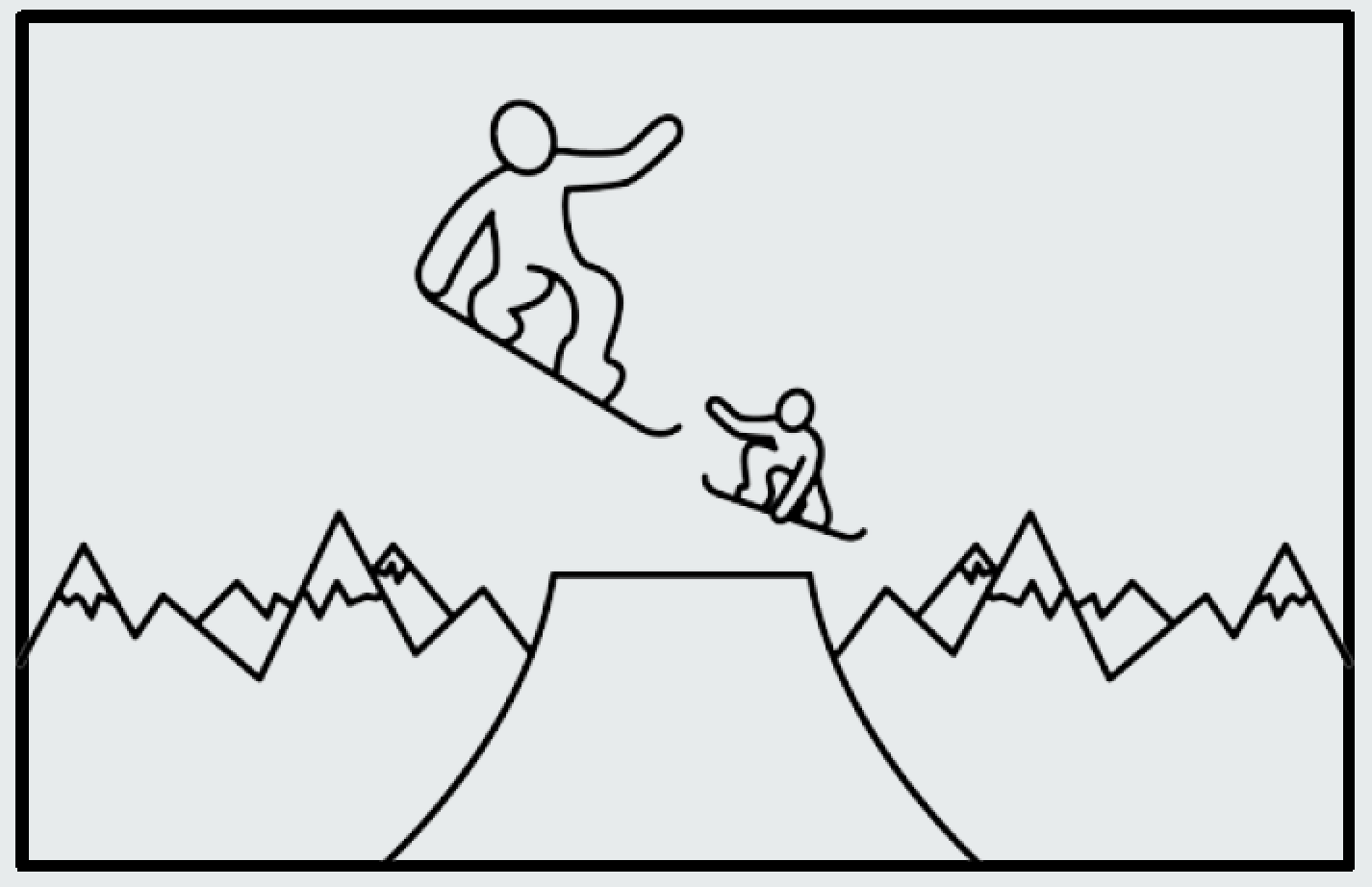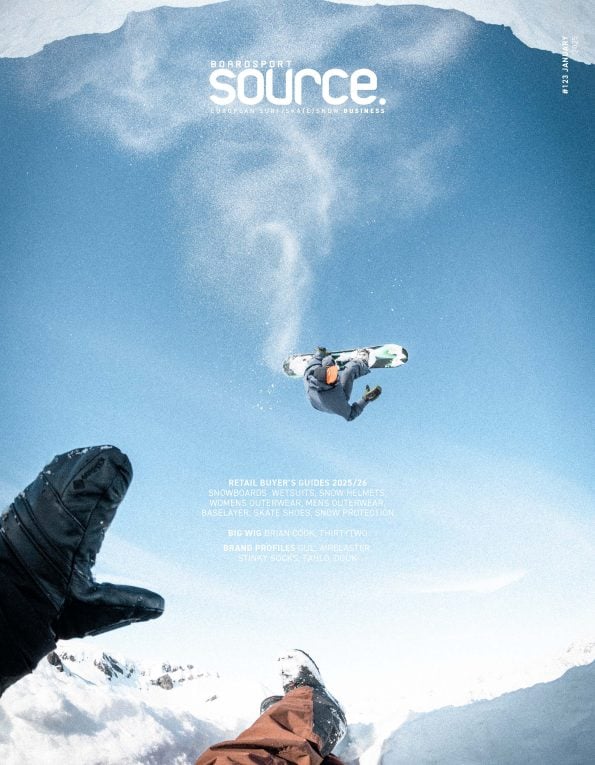
Kids Snowboarding – Lighting The Touchpaper
With participation in youth sports falling, how can snowboarding attract a new generation of kids? By Andrew Duthie.

Illustration by SOURCE
In the late 1990s I was at a barbeque, telling one of my uncles (and literally anyone else who’d listen – he’d drawn the short straw this time) about my new favourite thing in the world; snowboarding. After humouring me for a full five minutes at least, he interrupted in search of a clarification on one key point: “So are you lying down on this thing, or what?”
It says a lot about how rare snowboarding still was back then that this man – who, other than some fairly out-there opinions on digestive health, is pretty switched on – couldn’t even conjure it in his mind’s eye. It’s not, I would wager, something that’s anywhere near as likely to happen today.
While it’s now fully ingrained in the public consciousness, we’re two decades further down the road and snowboarding isn’t booming in the way that the fledgling teenage snowboarder I once was would have liked (not that anything would have been enough for that guy – ISIS recruitment videos display less fanaticism. And better dress sense).
Part of the problem is the fact that while snowboarding has become more accessible, so too have most things. If a family can afford snowboard lessons for their kids, there are myriad other options competing for that same cash. Plus, as attention spans have reportedly shortened – with mobile phones the prime suspect for that one – even the most entertaining pastime has its work cut out in keeping kids coming back for more.
It’s not a problem that’s exclusive to snowboarding by any means; these days the very notion of youth sports appears to be on a downward trajectory. Most of the available data has originated in the USA, where it’s a colossal and ever-growing business, and while the jury’s out over what exactly is to blame (the usual suspects include video games and overprotective parents) they all tell the same story: even as opportunities increase, the youth of today are less likely to be active participants in sport than that of the generation that preceded it.
Then there’s the fact that snowboarding in general remains in a relative lull – it may be ticking along, but we’re definitely no longer living in what was once described to me as ‘the Jamiroquai years’. Without attracting kids to snowboarding in considerable numbers, it paints a potentially bleak future for the sport. How likely are we to see the likes of Halldor and Eiki Helgason – who spent countless undistracted evenings jibbing a corrugated plastic pipe behind the ice rink in their home town of Akureyri, Iceland – again?
It follows that anything that can get more kids on a board, and keep them there, is to be encouraged – but once you factor in the relatively steep learning curve in potentially treacherous conditions, the deck appears stacked against a generation that supposedly thrives on instant gratification.
The trick, according to Barry Parker, Co-Owner of Morzine-based school REAL Snowboarding, is not to rush things. “It’s about letting the child enjoy the mountains,” he explains. “Part of the job is to help them enjoy the snow and learn to be safe. There are a lot of things you can do, that maybe to the untrained eye don’t look like part of a snowboard lesson, but at that age things like learning to walk in the snow, or make a snowball, or watch out for skiers crossing the piste, is really valuable stuff.”
To an extent, it’s a matter of letting the kids lead the lesson. Not only is this less likely to put them off, it’s also a bit more aligned with the roots of snowboarding. If you want to be drilled by a coach, there are plenty of options. If you want to discover things for yourself, that’s what this particular ‘sport’ has always been about.
As for the issue of distractions, it’s something Barry’s noticed coming up with slightly older kids, who are more likely to be heavy mobile phone users. “Are they at the lesson just so they can take a photo for Instagram? You do get that, but that’s just life – it’s just the way things are going. I don’t see it as detrimental to their motivation to snowboard. It’s not stopping them in any way, even if it occasionally interrupts things.”
So what’s the biggest obstacle, if it’s not that? Bas Elhordt runs Black Sheep Snowboard School in St Anton, through which he’s taught several hundred visitors and locals (as well as his own four-year-old son). He noticed that, in what is still a very ski-heavy resort, most of the snowboard lessons were being taken by highly qualified ski instructors with only a fundamental understanding of snowboarding.
As he puts it, “ski instructors are giving snowboard lessons for the money. They are not ‘real’ snowboarders, and you will never motivate people that way. It has to be something that you feel. I think it’s one of the biggest mistakes in the whole snowsports industry.” Bas set up Black Sheep a couple of seasons ago in order to provide the kind of specialist instruction that he felt was in short supply around the Alberg. “They want to have an expert, someone who’s been doing it for a long time.”
Barry agrees – even in the heart of the Portes du Soleil, which has served as a breeding ground for some of Europe’s finest snowboarders, the outdated national model of letting ski instructors take snowboard lessons (but not the other way around) is missing opportunities to get kids properly hooked.
Ironically, neither Barry nor Bas felt the heavy influence of their first instructor. “My first lessons were with a ‘ski guy’,” remembers Bas. “After three days of lessons, I was done – I said ‘OK, I can go snowboarding now’. One or two years later I was out with a snowboarder who was jumping cab 5s, finding natural hits, and that was completely different. Maybe he’s the reason I got where I am – he showed me the way”.
Retailers have a vital role to play here; if the shop staff know their onions, they’ll be uniquely placed to recommend the right instructors to parents when they’re buying gear. Indeed, Barry cites referrals from respected snowboard stores such as Boarderline in Aberdeen and Subvert in Manchester as instrumental in helping REAL get off the ground. It’s a win-win; if the instructor has successfully lit the touchpaper, the newly-converted kid (or more accurately, their grateful parent) will hopefully be a customer for years to come.
Speaking of which, you only need a quick look at what’s available for 2019 to see that getting kids on the right gear has never been easier, with a wealth of kid-specific models in ever-smaller size ranges (right down to the Burton Riglet setup, which has a retractable leash for pulling ankle-biters along flat ground).
Beginners can choose from the many lightweight, twin-shaped and flat-based (or gently rockered) boards that provide an ideal platform for those first steps. They may want to progress to something more technical before long, but it’ll last them at least until they need to trade for a bigger size anyway.
Then there’s the Bataleon Mini Shred, with the Triple Base design that further reduces the chance of edge catches. What was already a great choice for groms got a whole lot better this year, thanks to a massive drop in price. As Sales Manager Rubby Kiebert explains: “We dropped the price from €299 for a set, to €229. We felt it was the only way we could get a big group of young people riding full wood core camber 3BT boards that make snowboarding more fun and easy to learn without any downsides on carving progression for youngsters. We as family men know the cost of riding with the whole family, and we just saw around us that lots of kids were riding inferior products if you would compare it to what their parents were riding just to save some money. We felt like we had to make a move to get kids on quality stuff and put some positive energy in this next generation of riders.”
2019 is also a banner year for freeride-specific kids’ boards, often with tapered shapes and setback camber profiles – the YES PowInc, Jones Discovery and Burton Role Model to name just a few. Admittedly these cater more to those that are already well acquainted with snowboarding, and most likely living in the mountains, but you can’t accuse the brands of failing to do right by the youth. Jones even makes splitboards for groms (although if ever there were a niche within a niche within a niche, that’s it).
While any self-respecting snowboard seller would advise you never to make your choice based on the graphic, there’s no denying that younger riders respond to such things a lot more, and getting it wrong can be detrimental to the learning process. That being said, for every Spongebob Squarepants topsheet there are also boards that look just like Mum and Dad’s. Salomon, for example, uses the same designs on the junior versions of the Gypsy and Villain, as you’ll find on the adult models.
All of this means that kids who don’t like being pandered to don’t have to be, and those who approach a snowboard like having a new toy (no bad thing in those early days, if the Riglet’s popularity is anything to go by) are well catered for too. In any case, a big part of selling snowboarding to kids can be done in the shops. If clued-up staff can engage with younger customers, point them in the right direction and instill some of their own passion for snowboarding, that’ll be as attractive as any of the shiny new kit lining the shelves.
What we’re getting at here – whether it’s on the mountain, in the shop, round the BBQ pit or behind the ice rink – is what most of us call the ‘stoke’, and those who underestimate its importance only have themselves to blame when the kids go looking for something else to do. “Stoke”, as Barry puts it, “is a word that should be well known throughout the world. Everybody feels it – and if you sense it in somebody after your lesson, you know you’ve done a good job.”




